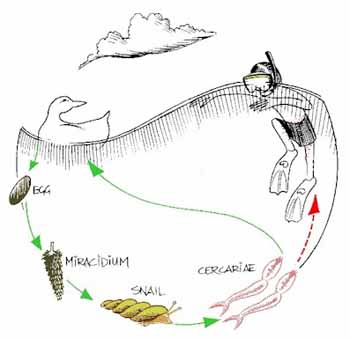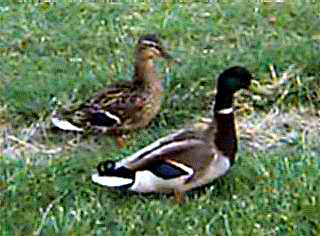Home → Water Quality → Lakes → Topics → Swimmer's Itch

Swimmer's Itch
Swimmers itch (Schistosome dermatitis) is a temporary skin infection acquired by bathers in some lakes when they accidentally become involved in the life cycle of the trematode worm. Cercariae penetrate the skin of bathers as water droplets dry. As penetration occurs a prickly, or itching sensation occurs followed by gereral inflammation of the affected area. Small red dots appear at the site of penetration. Itching can be mild to severe and can last several days.
Ducks are the most common host of the worm but other birds and mammals that spend their life in or around the water may also be a host.
Swimmer's Itch Life cycle
- The adult worms are parasites in the blood of aquatic birds and mammals. The worms lay eggs.
- The eggs are deposited on the bottom of the lake through droppings.
- The eggs hatch and free swimming animals called miracidia are released into the lake water.
- The miracidia penetrate snails and further develop into cercariae, minute free-swimming, fork-tailed colorless animals that are then released by the snails.
- The Cercariae find a host (aquatic birds, mammals or humans). The skin is penetrated and if a suitable host is found the life cycle starts all over again. Humans are not a suitable host and the cercariae die after penetrating the skin.
The only sure way to prevent Swimmer's Itch is to stay out of the water when the cercariae are present, but the following can reduce the chances of contacting Swimmer's Itch.
- Apply a water repellant substance such as petroleum jelly, waterproof sunscreen or other skin oils to reduce the ability of the Cercariae from penetrating the skin.
- Rub down briskly with a towel when emerging from the water. If cercariae are on the skin they will try to penetrate the moment you emerge from the water.
- Swim in deeper waters, not the shallow areas near shore. Near shore is where the cercariae tend to concentrate.
- Swim in areas with an off-shore breeze. The cercariae are weak swimmers and are blown about by the wind.
Some other web sites with information about swimmer's itch are listed below.
Fact sheet on swimmers itch from the Centers for Disease Control and Prevention (CDC).
Picture of the rash from the Mayo Clinic (offsite).
